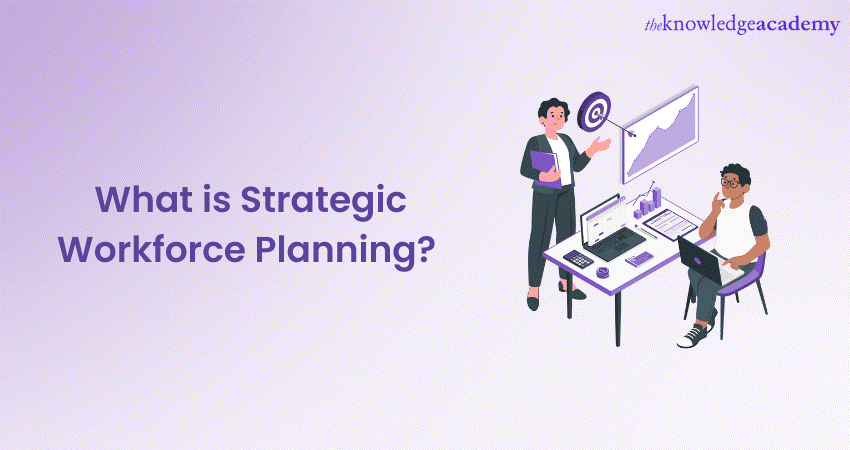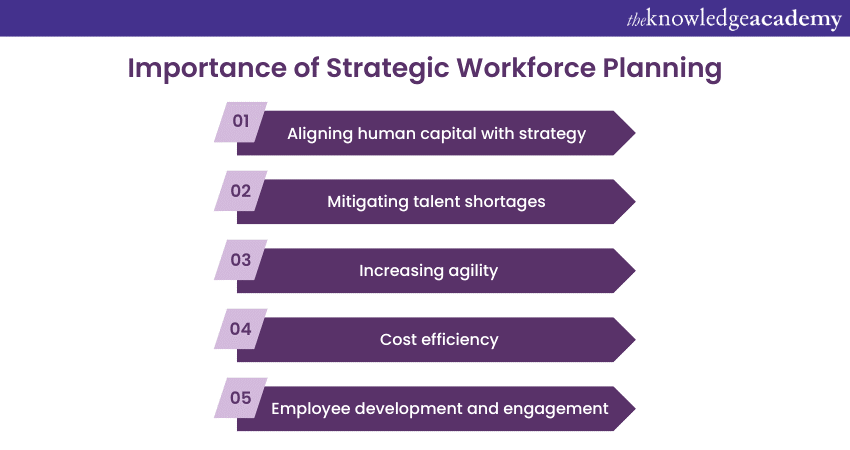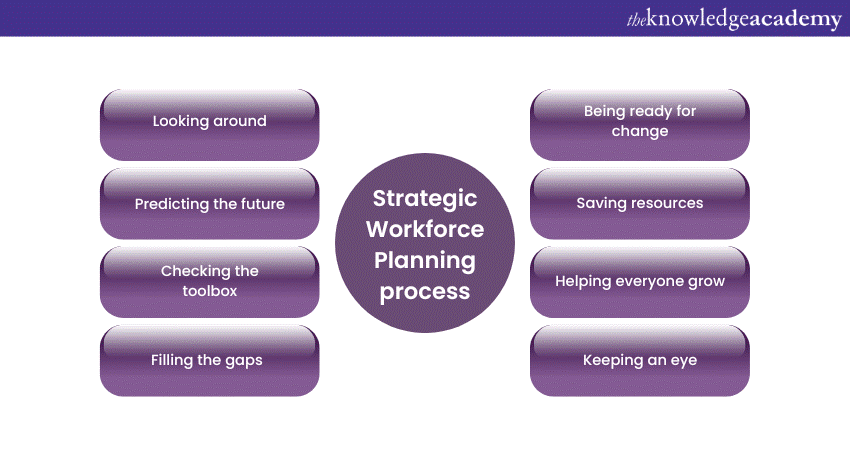We may not have the course you’re looking for. If you enquire or give us a call on +91-181-5047001 and speak to our training experts, we may still be able to help with your training requirements.
Training Outcomes Within Your Budget!
We ensure quality, budget-alignment, and timely delivery by our expert instructors.

A simple answer to the question "What is Strategic Workforce Planning?" would be that it is about preparing for the future. In a world where things change rapidly, Strategic Workforce Planning helps HR departments determine the right people a company will require. It involves planning and developing a strategy to obtain the optimal combination of talent, technology, and work styles to enable the company to achieve its objectives.
Discover the essence of Strategic Workforce Planning in this comprehensive blog. Learn What is Strategic Workforce Planning, explore real-world examples, and grasp its significance in modern business dynamics. Read more!
Table of Contents
1) Definition of Strategic Workforce Planning
2) Importance of Strategic Workforce Planning
3) Strategic Workforce Planning examples
4) Strategic Workforce Planning process
5) Benefits of Strategic Workforce Planning
6) Challenges of Strategic Workforce Planning
7) Conclusion
Definition of Strategic Workforce Planning
Strategic Workforce Planning is the process where companies figure out what kind of employees they need for their future goals. They look at their current employees and skills and then predict what skills will be important later. This helps them prepare for changes and ensure they have the right people for their plans.
It involves looking at the workers' skills the company has now and seeing if those skills match in the future. If there are gaps, it means certain skills are missing. Then, the company plans to train current employees or hire new ones with the needed skills. This way, the company can stay prepared and successful even as things change.
In the end, Strategic Workforce Planning is a strategy companies use to ensure they have the right employees with the right skills at the right time. It's about looking ahead, understanding what's important, and ensuring the workforce is ready for challenges and opportunities.
Importance of Strategic Workforce Planning

Strategic Workforce Planning is important for companies to achieve success. It's like having a plan for a game to make sure you win. Let's see why it matters a lot.
Aligning human capital with strategy
Strategic Workforce Planning ensures that a company's workforce aligns with its strategic objectives. It's about having the right people with the right skills in the right positions to achieve the company's goals.
When there's alignment between the skills and competencies of the employees and the company's strategic direction, it fosters a sense of purpose and unity. This alignment boosts operational efficiency, encourages collaborative efforts, and stimulates innovation.
Mitigating talent shortages
Talent shortages can disrupt operations and hinder growth. Strategic Workforce Planning is an approach to address this challenge. Companies can take necessary actions by analysing future skills needs and identifying potential gaps. It involves forecasting the skills and talents in demand based on business projections.
This enables organisations to invest in training and development initiatives. It ensures that their existing employees acquire the necessary skills. Moreover, it allows the company to hire individuals with the required skills strategically, preventing sudden scarcity.
Increasing agility
The business world changes quickly, and companies need to be able to change with it. Strategic Workforce Planning allows a company to move its employees around when needed. This means that if one part of the company needs more help, employees from other parts can step in. It's like having a team where everyone can play different positions to respond to different situations.
Cost efficiency
Having too many or too few employees can cost a company a lot of money. Strategic Workforce Planning helps a company find the right balance. It prevents hiring too many people, which would mean paying more than needed.
It also avoids having too few employees, which might lead to missed opportunities and less work getting done. This balance saves money and keeps the company running smoothly.
Employee development and engagement
Strategic Workforce Planning involves figuring out where employees need to improve their skills. This allows employees to learn new things and improve at their jobs. Employees become more motivated when they see that the company cares about their growth.
They know that the company supports their career development. This feeling makes them more likely to stay loyal and enthusiastic about their work.
Strategic Workforce Planning examples
Let's look at some real-world examples to understand how Strategic Workforce Planning works:
Amazon
Amazon is known for its speedy deliveries and wide selection of products. Behind the scenes, Strategic Workforce Planning helps Amazon keep up its fast-paced operations. Imagine if Amazon didn't plan ahead – during busy times, they might not have enough workers to pack and ship orders.
With Strategic Workforce Planning, Amazon forecasts how many orders they'll get and makes sure they have enough employees to handle the rush. This keeps customers happy and deliveries on time.
General Electric (GE)
General Electric, a company in various industries like aviation and energy, uses Strategic Workforce Planning to stay ahead. Let's focus on their aviation division. Imagine if GE didn't think about the future – they might not have enough engineers to design new aeroplane engines.
With Strategic Workforce Planning, GE anticipates the skills they'll need. For instance, they might predict that new technologies like 3D printing will be important. So, they train their current engineers and even hire new ones with expertise in these technologies.
Procter & Gamble (P&G)
P&G, a big name in consumer goods, also relies on Strategic Workforce Planning. What if P&G didn't plan for changes – they might miss out on trends like eco-friendly products.
Through implementing Strategic Workforce Planning, P&G identifies future needs. For example, as more people want sustainable products, they plan to hire employees who know about environmentally friendly manufacturing. This way, they can keep up with customers' wants and stay successful.
Small business café
Even small businesses benefit from Strategic Workforce Planning. Consider a café. If the café doesn't plan, they might not have enough staff during busy hours. With proper and effective planning, the café looks at its sales data and figures out when it needs more workers. This helps them serve customers quickly and keep them coming back.
Healthcare clinic
A healthcare clinic also uses Strategic Workforce Planning. Imagine if they didn't think ahead – they might not have enough doctors and nurses to care for patients. The clinic estimates how many patients they'll have and what medical skills will be required through planning for the future. This way, they can hire or train enough healthcare professionals to give proper care.
These examples show that Strategic Workforce Planning isn't just for big companies – it's a smart strategy that all kinds of businesses use to be ready for the future.
Supercharge your team's growth with the Team Development Masterclass today!
Strategic Workforce Planning process
There are various steps through which this strategic planning is carried out. Some of the basic important processes are discussed below:

Looking around
At the beginning of Strategic Workforce Planning, companies closely examine their existing workforce. This entails evaluating the skills, roles, and strengths of the employees currently in the organisation. By doing so, companies clearly understand their workforce's current composition and capabilities.
Unlock Success with our Workforce Resource Planning Training. Join Now!
Predicting the future
In this stage, companies use data and insights to forecast the skills and talent they will need in the future. This involves considering factors like industry trends, business expansion plans, and emerging technologies. Companies aim to align their workforce with the expected future demands by making educated projections.
Checking the toolbox
Much like a quality control check before production, companies evaluate the skills of their employees. This is to determine if they align with the organisation's future requirements. This evaluation helps pinpoint any disparities between current skills and those necessary for upcoming projects or goals. This step lays the groundwork for developing strategies to address these skill gaps, whether through training, recruitment, or other relevant measures
Filling the gaps
Once skill gaps are identified, companies take steps to address them. This involves determining how to bridge the difference between the skills currently available and the skills needed for future tasks.
Strategies might include training existing employees to acquire the required skills or seeking new talent with the necessary expertise. Similar to completing a puzzle by finding the missing pieces, companies ensure they have a complete and capable workforce to meet their goals.
Being ready for change
Companies understand that change is inevitable, much like unexpected weather during an event. To adapt, they create contingency plans. These plans involve having a flexible workforce that can be moved to different roles or projects as needed.
This flexibility ensures that the company can respond swiftly to unforeseen challenges, maintaining smooth operations even when unexpected changes occur.
Transform your team into a cohesive force for excellence with our Team Development Masterclass. Sign up today!
Saving resources
Like managing a budget wisely, companies optimise their workforce to avoid unnecessary costs. Having too many employees or too few can be costly. To strike the right balance, companies ensure they have the right number of employees with the appropriate skills.
This prevents wastage of resources, such as overpaying for excessive staff or losing out on opportunities due to insufficient manpower. By aligning their workforce accurately, companies can allocate resources efficiently and remain competitive.
Helping everyone grow
They provide chances for employees to improve their abilities through training and development programs. This not only benefits the employees by making them more skilled but also boosts their job satisfaction and commitment. Employees become more engaged and motivated when they see the company's commitment to their professional growth.
Keeping an eye
Companies maintain constant monitoring of their workforce planning efforts. They assess whether their strategies are working effectively or if adjustments are necessary. If something isn't going as planned, they modify their approach.
This observation is crucial to ensure that the workforce remains aligned with the company's goals and adaptable to any changes. Just as a vigilant cook ensures the meal is on track, companies keep a watchful eye to steer their workforce planning in the right direction.
Benefits of Strategic Workforce Planning
Enhanced adaptability: SWP enables organisations to anticipate and prepare for changes in the business environment. By identifying future skill requirements and potential talent gaps, organisations can proactively address shifts in technology, market demands, and industry trends.
Optimised resource allocation: Effective SWP ensures that the right people are in the right roles at the right time. This leads to improved efficiency, reduced redundancies, and better utilisation of human capital resources.
Talent retention and engagement: When employees see a clear path for their growth within an organisation, they are more likely to remain engaged and committed. SWP facilitates the identification of high-potential employees and provides avenues for their development, increasing employee retention rates.
Challenges of Strategic Workforce Planning
Data accuracy and availability: SWP heavily relies on accurate and up-to-date data. Ensuring the quality and availability of workforce-related data can be challenging, especially for organisations with disparate systems or data silos.
Predicting future needs: While SWP aims to anticipate future workforce requirements, predicting exact skill needs in a rapidly changing landscape can be complex. Changes in technology, market dynamics, and unexpected events can impact the accuracy of projections.
Resistance to Change: Implementing SWP may require changes in existing processes, job roles, or reporting structures. Resistance from employees and stakeholders who are accustomed to the status quo can hinder the successful adoption of SWP strategies.
Conclusion
Knowing What is Strategic Workforce Planning helps companies prepare for the future. It's more than just managing the number of employees. It's about ensuring the employees have the right skills for the company's goals. Irrespective of the company’s size, Strategic Workforce Planning is a tool that helps it grow and succeed in the future.
Equip yourself with essential skills through our diverse Management Training, paving the way for your professional advancement.
Frequently Asked Questions
Upcoming Business Skills Resources Batches & Dates
Date
 Workforce Resource Planning Training
Workforce Resource Planning Training
Fri 28th Feb 2025
Fri 4th Apr 2025
Fri 27th Jun 2025
Fri 29th Aug 2025
Fri 24th Oct 2025
Fri 5th Dec 2025







 Top Rated Course
Top Rated Course



 If you wish to make any changes to your course, please
If you wish to make any changes to your course, please


